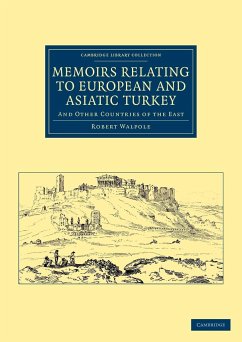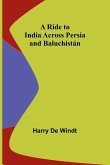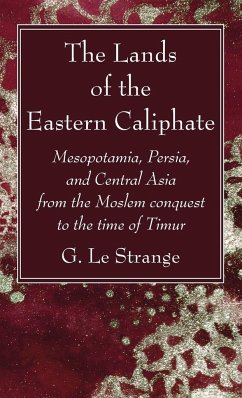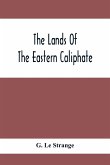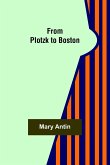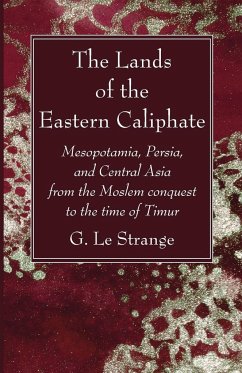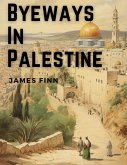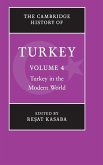- Broschiertes Buch
- Merkliste
- Auf die Merkliste
- Bewerten Bewerten
- Teilen
- Produkt teilen
- Produkterinnerung
- Produkterinnerung
Published in 1817 and reissued in 1818, this is a compendium of travel and other writings on Greece and Turkey.
Andere Kunden interessierten sich auch für
![A Ride to India across Persia and Baluchistán A Ride to India across Persia and Baluchistán]() Harry De WindtA Ride to India across Persia and Baluchistán19,99 €
Harry De WindtA Ride to India across Persia and Baluchistán19,99 €![The Lands of the Eastern Caliphate The Lands of the Eastern Caliphate]() G. Le StrangeThe Lands of the Eastern Caliphate67,99 €
G. Le StrangeThe Lands of the Eastern Caliphate67,99 €![The Lands Of The Eastern Caliphate The Lands Of The Eastern Caliphate]() G. Le StrangeThe Lands Of The Eastern Caliphate34,99 €
G. Le StrangeThe Lands Of The Eastern Caliphate34,99 €![From Plotzk to Boston From Plotzk to Boston]() Mary AntinFrom Plotzk to Boston17,99 €
Mary AntinFrom Plotzk to Boston17,99 €![The Lands of the Eastern Caliphate The Lands of the Eastern Caliphate]() G. Le StrangeThe Lands of the Eastern Caliphate52,99 €
G. Le StrangeThe Lands of the Eastern Caliphate52,99 €![Byeways In Palestine Byeways In Palestine]() James FinnByeways In Palestine18,99 €
James FinnByeways In Palestine18,99 €![The Cambridge History of Turkey The Cambridge History of Turkey]() Re Kasaba (?) at (ed.)The Cambridge History of Turkey260,99 €
Re Kasaba (?) at (ed.)The Cambridge History of Turkey260,99 €-
-
-
Published in 1817 and reissued in 1818, this is a compendium of travel and other writings on Greece and Turkey.
Hinweis: Dieser Artikel kann nur an eine deutsche Lieferadresse ausgeliefert werden.
Hinweis: Dieser Artikel kann nur an eine deutsche Lieferadresse ausgeliefert werden.
Produktdetails
- Produktdetails
- Verlag: Cambridge University Press
- Seitenzahl: 678
- Erscheinungstermin: 6. Januar 2012
- Englisch
- Abmessung: 297mm x 210mm x 36mm
- Gewicht: 1729g
- ISBN-13: 9781108044028
- ISBN-10: 1108044026
- Artikelnr.: 34960703
- Herstellerkennzeichnung
- Libri GmbH
- Europaallee 1
- 36244 Bad Hersfeld
- gpsr@libri.de
- Verlag: Cambridge University Press
- Seitenzahl: 678
- Erscheinungstermin: 6. Januar 2012
- Englisch
- Abmessung: 297mm x 210mm x 36mm
- Gewicht: 1729g
- ISBN-13: 9781108044028
- ISBN-10: 1108044026
- Artikelnr.: 34960703
- Herstellerkennzeichnung
- Libri GmbH
- Europaallee 1
- 36244 Bad Hersfeld
- gpsr@libri.de
Preliminary Dissertation: the causes of the weakness and decline of the Turkish monarchy
and some remarks on the system of government pursued in the European and Asiatic provinces of the Empire
by the editor; 1. Note respecting the massacre of the Mamelukes by the Turks
in the year 1811; 2. Account of a journey through the district of Maina in the Morea
communicated by Mr. Morritt; 3. Remarks illustrating part of the preceding journal
from the papers of the late Dr Sibthorp; 4. Parnassus
and the neighbouring district
from the manuscripts of the late Dr Sibthorp; 5. Observations on natural history relating to parts of Greece
and the island of Cyprus
from the same; 6. Journey from Parium to the Troad. Ascent to the summit of Ida. The salt springs of Tousla. Ruins of Assos
from the journals of Dr Hunt; 7. Remarks respecting Attica
from the journals of the late Dr Sibthorp; 8. Letters from the late Professor Carlyle
during his residence in Turkey
to the Lord Bishop of Lincoln. Letters from the same
to the Lord Bishop of Durham; 9. Mount Athos. An account of the monastic institutions
and the libraries on the holy mountain
from the papers of Dr Hunt; 10. Additional remarks on the sepulchres of the European and Asiatic Greeks
by the editor; 11. Notice respecting Dr Sibthorp's journals
by the editor; 12. Medicinal and economical uses of the plants of Greece
from the papers of the late Dr Sibthorp; 13. Plants collected in Cyprus
by Dr Hume; 14. Birds
quadrupeds
and fishes of Greece and Cyprus
with their names in Romaic
from the papers of Dr Sibthorp; 15. On the various modes of fishing practised by the modern Greeks
by the editor; 16. Various extracts from Dr Sibthorp's journals; 17. On the olives and vines of Zante. On the corn cultivated in that island
and in parts of the ancient Boeotia. The produce of corn in some districts of Greece
from the papers of Dr Sibthorp
and from some remarks communicated by Mr Hawkins; 18. Journal through parts of Boeotia and Phocis
communicated by Mr Raikes; 19. Remarks relating to the military architecture of the Ancient Greeks
from the journals of the late Colonel Squire; 20. Antiquities of Athens. Explanation of the subject of the vases facing p.325 and p.327
and of the sigillarium
by the editor; 21. Excavations in the tombs of Attica; 22. The plain of Marathon
from the papers of the late Col. Squire; 23. Remarks on parts of the continent of Greece
from the same; 24. The Isthmus of Corinth
from the same; 25. Observations relating to some of the antiquities of Egypt
from the journals of the late Mr Davison; 26. The catacombs of Alexandria
by the editor; 27. Remarks on the manners and customs of the modern inhabitants of Egypt
from the journals of Dr Hume; 28. Journal of a voyage up the Nile into part of Nubia
in May 1814
by Captain Light; 29. On the mines of Laurium. Gold and silver coinage of the Athenians. Revenue of Attica
by the editor and the Earl of Aberdeen; 30. Remarks on two sculptured marbles brought from Amyclae
by the Earl of Aberdeen; 31. Illustration of various Greek inscriptions
by the editor; 32. On the topography of Athens
by Mr Hawkins; 33. On the long walls which connected Athens with the Piraeus; 34. The Vale of Tempe
by Mr Hawkins; 35. The Syrinx of Strabo
and the passage of the Euripus
by Mr Hawkins; 36. Panoramic views of Athens
illustrated by Mr Haygarth; 37. Remarks on the thesauri of the Greeks
by the editor; 38. Remarks on the Troad
contained in a letter from Mr Morritt to Dr Clarke; 39. Remarks on the architectural inscription brought from Athens
and now preserved in the British Museum
by Mr Wilkins; 40. References to Mr Foster's map of the Troad; 41. Remarks on the Demetrian system of the Troad
by the editor.
and some remarks on the system of government pursued in the European and Asiatic provinces of the Empire
by the editor; 1. Note respecting the massacre of the Mamelukes by the Turks
in the year 1811; 2. Account of a journey through the district of Maina in the Morea
communicated by Mr. Morritt; 3. Remarks illustrating part of the preceding journal
from the papers of the late Dr Sibthorp; 4. Parnassus
and the neighbouring district
from the manuscripts of the late Dr Sibthorp; 5. Observations on natural history relating to parts of Greece
and the island of Cyprus
from the same; 6. Journey from Parium to the Troad. Ascent to the summit of Ida. The salt springs of Tousla. Ruins of Assos
from the journals of Dr Hunt; 7. Remarks respecting Attica
from the journals of the late Dr Sibthorp; 8. Letters from the late Professor Carlyle
during his residence in Turkey
to the Lord Bishop of Lincoln. Letters from the same
to the Lord Bishop of Durham; 9. Mount Athos. An account of the monastic institutions
and the libraries on the holy mountain
from the papers of Dr Hunt; 10. Additional remarks on the sepulchres of the European and Asiatic Greeks
by the editor; 11. Notice respecting Dr Sibthorp's journals
by the editor; 12. Medicinal and economical uses of the plants of Greece
from the papers of the late Dr Sibthorp; 13. Plants collected in Cyprus
by Dr Hume; 14. Birds
quadrupeds
and fishes of Greece and Cyprus
with their names in Romaic
from the papers of Dr Sibthorp; 15. On the various modes of fishing practised by the modern Greeks
by the editor; 16. Various extracts from Dr Sibthorp's journals; 17. On the olives and vines of Zante. On the corn cultivated in that island
and in parts of the ancient Boeotia. The produce of corn in some districts of Greece
from the papers of Dr Sibthorp
and from some remarks communicated by Mr Hawkins; 18. Journal through parts of Boeotia and Phocis
communicated by Mr Raikes; 19. Remarks relating to the military architecture of the Ancient Greeks
from the journals of the late Colonel Squire; 20. Antiquities of Athens. Explanation of the subject of the vases facing p.325 and p.327
and of the sigillarium
by the editor; 21. Excavations in the tombs of Attica; 22. The plain of Marathon
from the papers of the late Col. Squire; 23. Remarks on parts of the continent of Greece
from the same; 24. The Isthmus of Corinth
from the same; 25. Observations relating to some of the antiquities of Egypt
from the journals of the late Mr Davison; 26. The catacombs of Alexandria
by the editor; 27. Remarks on the manners and customs of the modern inhabitants of Egypt
from the journals of Dr Hume; 28. Journal of a voyage up the Nile into part of Nubia
in May 1814
by Captain Light; 29. On the mines of Laurium. Gold and silver coinage of the Athenians. Revenue of Attica
by the editor and the Earl of Aberdeen; 30. Remarks on two sculptured marbles brought from Amyclae
by the Earl of Aberdeen; 31. Illustration of various Greek inscriptions
by the editor; 32. On the topography of Athens
by Mr Hawkins; 33. On the long walls which connected Athens with the Piraeus; 34. The Vale of Tempe
by Mr Hawkins; 35. The Syrinx of Strabo
and the passage of the Euripus
by Mr Hawkins; 36. Panoramic views of Athens
illustrated by Mr Haygarth; 37. Remarks on the thesauri of the Greeks
by the editor; 38. Remarks on the Troad
contained in a letter from Mr Morritt to Dr Clarke; 39. Remarks on the architectural inscription brought from Athens
and now preserved in the British Museum
by Mr Wilkins; 40. References to Mr Foster's map of the Troad; 41. Remarks on the Demetrian system of the Troad
by the editor.
Preliminary Dissertation: the causes of the weakness and decline of the Turkish monarchy
and some remarks on the system of government pursued in the European and Asiatic provinces of the Empire
by the editor; 1. Note respecting the massacre of the Mamelukes by the Turks
in the year 1811; 2. Account of a journey through the district of Maina in the Morea
communicated by Mr. Morritt; 3. Remarks illustrating part of the preceding journal
from the papers of the late Dr Sibthorp; 4. Parnassus
and the neighbouring district
from the manuscripts of the late Dr Sibthorp; 5. Observations on natural history relating to parts of Greece
and the island of Cyprus
from the same; 6. Journey from Parium to the Troad. Ascent to the summit of Ida. The salt springs of Tousla. Ruins of Assos
from the journals of Dr Hunt; 7. Remarks respecting Attica
from the journals of the late Dr Sibthorp; 8. Letters from the late Professor Carlyle
during his residence in Turkey
to the Lord Bishop of Lincoln. Letters from the same
to the Lord Bishop of Durham; 9. Mount Athos. An account of the monastic institutions
and the libraries on the holy mountain
from the papers of Dr Hunt; 10. Additional remarks on the sepulchres of the European and Asiatic Greeks
by the editor; 11. Notice respecting Dr Sibthorp's journals
by the editor; 12. Medicinal and economical uses of the plants of Greece
from the papers of the late Dr Sibthorp; 13. Plants collected in Cyprus
by Dr Hume; 14. Birds
quadrupeds
and fishes of Greece and Cyprus
with their names in Romaic
from the papers of Dr Sibthorp; 15. On the various modes of fishing practised by the modern Greeks
by the editor; 16. Various extracts from Dr Sibthorp's journals; 17. On the olives and vines of Zante. On the corn cultivated in that island
and in parts of the ancient Boeotia. The produce of corn in some districts of Greece
from the papers of Dr Sibthorp
and from some remarks communicated by Mr Hawkins; 18. Journal through parts of Boeotia and Phocis
communicated by Mr Raikes; 19. Remarks relating to the military architecture of the Ancient Greeks
from the journals of the late Colonel Squire; 20. Antiquities of Athens. Explanation of the subject of the vases facing p.325 and p.327
and of the sigillarium
by the editor; 21. Excavations in the tombs of Attica; 22. The plain of Marathon
from the papers of the late Col. Squire; 23. Remarks on parts of the continent of Greece
from the same; 24. The Isthmus of Corinth
from the same; 25. Observations relating to some of the antiquities of Egypt
from the journals of the late Mr Davison; 26. The catacombs of Alexandria
by the editor; 27. Remarks on the manners and customs of the modern inhabitants of Egypt
from the journals of Dr Hume; 28. Journal of a voyage up the Nile into part of Nubia
in May 1814
by Captain Light; 29. On the mines of Laurium. Gold and silver coinage of the Athenians. Revenue of Attica
by the editor and the Earl of Aberdeen; 30. Remarks on two sculptured marbles brought from Amyclae
by the Earl of Aberdeen; 31. Illustration of various Greek inscriptions
by the editor; 32. On the topography of Athens
by Mr Hawkins; 33. On the long walls which connected Athens with the Piraeus; 34. The Vale of Tempe
by Mr Hawkins; 35. The Syrinx of Strabo
and the passage of the Euripus
by Mr Hawkins; 36. Panoramic views of Athens
illustrated by Mr Haygarth; 37. Remarks on the thesauri of the Greeks
by the editor; 38. Remarks on the Troad
contained in a letter from Mr Morritt to Dr Clarke; 39. Remarks on the architectural inscription brought from Athens
and now preserved in the British Museum
by Mr Wilkins; 40. References to Mr Foster's map of the Troad; 41. Remarks on the Demetrian system of the Troad
by the editor.
and some remarks on the system of government pursued in the European and Asiatic provinces of the Empire
by the editor; 1. Note respecting the massacre of the Mamelukes by the Turks
in the year 1811; 2. Account of a journey through the district of Maina in the Morea
communicated by Mr. Morritt; 3. Remarks illustrating part of the preceding journal
from the papers of the late Dr Sibthorp; 4. Parnassus
and the neighbouring district
from the manuscripts of the late Dr Sibthorp; 5. Observations on natural history relating to parts of Greece
and the island of Cyprus
from the same; 6. Journey from Parium to the Troad. Ascent to the summit of Ida. The salt springs of Tousla. Ruins of Assos
from the journals of Dr Hunt; 7. Remarks respecting Attica
from the journals of the late Dr Sibthorp; 8. Letters from the late Professor Carlyle
during his residence in Turkey
to the Lord Bishop of Lincoln. Letters from the same
to the Lord Bishop of Durham; 9. Mount Athos. An account of the monastic institutions
and the libraries on the holy mountain
from the papers of Dr Hunt; 10. Additional remarks on the sepulchres of the European and Asiatic Greeks
by the editor; 11. Notice respecting Dr Sibthorp's journals
by the editor; 12. Medicinal and economical uses of the plants of Greece
from the papers of the late Dr Sibthorp; 13. Plants collected in Cyprus
by Dr Hume; 14. Birds
quadrupeds
and fishes of Greece and Cyprus
with their names in Romaic
from the papers of Dr Sibthorp; 15. On the various modes of fishing practised by the modern Greeks
by the editor; 16. Various extracts from Dr Sibthorp's journals; 17. On the olives and vines of Zante. On the corn cultivated in that island
and in parts of the ancient Boeotia. The produce of corn in some districts of Greece
from the papers of Dr Sibthorp
and from some remarks communicated by Mr Hawkins; 18. Journal through parts of Boeotia and Phocis
communicated by Mr Raikes; 19. Remarks relating to the military architecture of the Ancient Greeks
from the journals of the late Colonel Squire; 20. Antiquities of Athens. Explanation of the subject of the vases facing p.325 and p.327
and of the sigillarium
by the editor; 21. Excavations in the tombs of Attica; 22. The plain of Marathon
from the papers of the late Col. Squire; 23. Remarks on parts of the continent of Greece
from the same; 24. The Isthmus of Corinth
from the same; 25. Observations relating to some of the antiquities of Egypt
from the journals of the late Mr Davison; 26. The catacombs of Alexandria
by the editor; 27. Remarks on the manners and customs of the modern inhabitants of Egypt
from the journals of Dr Hume; 28. Journal of a voyage up the Nile into part of Nubia
in May 1814
by Captain Light; 29. On the mines of Laurium. Gold and silver coinage of the Athenians. Revenue of Attica
by the editor and the Earl of Aberdeen; 30. Remarks on two sculptured marbles brought from Amyclae
by the Earl of Aberdeen; 31. Illustration of various Greek inscriptions
by the editor; 32. On the topography of Athens
by Mr Hawkins; 33. On the long walls which connected Athens with the Piraeus; 34. The Vale of Tempe
by Mr Hawkins; 35. The Syrinx of Strabo
and the passage of the Euripus
by Mr Hawkins; 36. Panoramic views of Athens
illustrated by Mr Haygarth; 37. Remarks on the thesauri of the Greeks
by the editor; 38. Remarks on the Troad
contained in a letter from Mr Morritt to Dr Clarke; 39. Remarks on the architectural inscription brought from Athens
and now preserved in the British Museum
by Mr Wilkins; 40. References to Mr Foster's map of the Troad; 41. Remarks on the Demetrian system of the Troad
by the editor.

